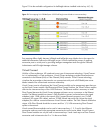The Onboard Administrator aggregates up to eight iLO 2 ports in a c3000 Enclosure, simplifying
cable management and providing a graphical interface to launch individual server iLO management
interfaces.
The rear of each module has an LED (blue unit identification) that can be enabled locally or remotely
and can be used to identify the enclosure from the back of the rack.
The c3000 Enclosure currently supports one Onboard Administrator module. Enclosure devices
continue to operate normally in the event of a hardware failure or removal; however, management
capabilities of the enclosure are lost. Enclosure fans run at full speed to ensure adequate cooling
when no Onboard Administrator is present.
Onboard Administrator collects system parameters related to thermal and power status, system
configuration, and managed network configuration. It manages these variables cohesively and
intelligently so that IT personnel can configure the HP BladeSystem c-Class and manage it in a fraction
of the time that other solutions require.
Onboard Administrator retrieves thermal information from the components in the enclosure. If the
enclosure’s thermal load increases, the Onboard Administrator’s thermal logic feature instructs the fan
controllers to increase fan speeds to accommodate the additional demand. Individual fan speeds can
be adjusted to reduce noise and power consumption, and to compensate for airflow differences
within the enclosure. Performance of each subsystem is proactively monitored, and any failures or
warnings can be reported to the system log and to broader infrastructure management tools such as
HP Systems Insight Manager (when SNMP is enabled). The Onboard Administrator manages
subsystem failure by taking appropriate action, including adjusting fan speed or reducing power
consumption, to maintain the enclosure’s ability to operate.
The Onboard Administrator uses sophisticated power measurement sensors to accurately monitor
exactly how much power is being consumed and how much power is available. Because Onboard
Administrator uses real-time measured power data instead of maximum power envelopes, customers
can deploy as many servers and interconnect modules as possible for the available power.
Onboard Administrator includes logic to manage multiple enclosures in a rack. The Onboard
Administrator allows single-point access for up to four enclosures. Thus, an IT administrator can use a
single sign-on to log into a single Onboard Administrator and use the web GUI to graphically view
and manage all the c-Class components within the linked enclosures. For example, an IT administrator
could automatically propagate management commands—such as putting an upper limit on power
levels for all server blades—throughout the linked enclosures.
A major advantage of the HP BladeSystem c-Class is its configuration flexibility. The configuration
logic resides in the management controller module in the front of the enclosure. The Onboard
Administrator module communicates with the iLO 2 management processor on each server blade to
form the core of the management architecture for HP BladeSystem c-Class. The configuration logic
powers up the interconnect modules first. Server blades are not powered up until the Onboard
Administrator has verified that the configuration is correct. If there is a configuration issue, the Insight
Display identifies the issue and possible remedies.
To assist IT administrators in the configuration and setup process, the Onboard Administrator verifies
four attributes for each server blade and interconnect module as they are added to the enclosure:
• Electronic keying—The Onboard Administrator automatically queries all mezzanine cards and
interconnect modules as they are deployed to check whether the interconnect fabric types match. If
they do not, the Onboard Administrator issues a warning with suggested corrective action.
• Power—The Onboard Administrator ensures that sufficient power is available to power up a server
blade or interconnect module.
18


















